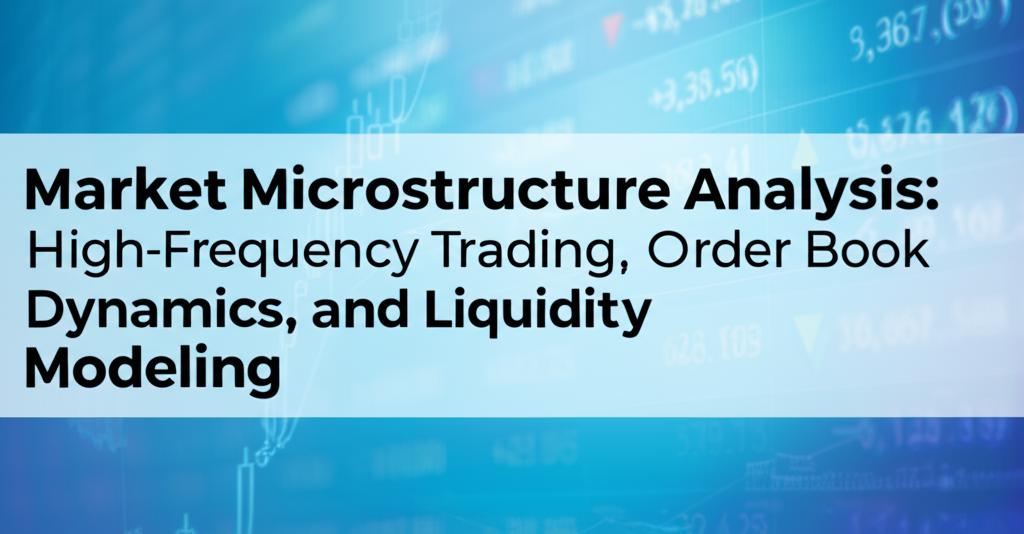Market microstructure delves into the intricate mechanics of how trading processes influence price formation, liquidity, and overall market quality. With the rise of electronic trading and the vast amounts of high-frequency data now available, understanding these microscopic interactions has become essential for navigating today's complex financial landscape. This analysis focuses on key components: high-frequency trading (HFT), the dynamics within limit order books (LOBs), and the modeling of market liquidity.
High-Frequency Trading: Speed and StrategyHigh-Frequency Trading employs powerful computers and complex algorithms to execute orders at extremely high speeds, often leveraging tiny price discrepancies or providing liquidity. HFT isn't a single strategy but encompasses various approaches, from market making to statistical arbitrage. Its impact is significant, often accounting for a large share of trading volume in major markets.
The influence of HFT on market quality is a subject of ongoing debate. Proponents argue that HFT enhances liquidity by tightening bid-ask spreads and contributes to faster price discovery, ensuring prices rapidly reflect new information. However, critics raise concerns about "transient liquidity," where HFT firms rapidly place and cancel orders, potentially creating illusory depth that disappears during stress. Some HFT strategies might also anticipate large institutional orders, leading to adverse market impact for slower traders. Regulatory bodies worldwide continue to scrutinize HFT's role, focusing on market stability, fairness, and potential for market abuse, highlighting the complexity and unintended consequences within the evolving market structure.
Order Book Dynamics: Unveiling Trader IntentThe Limit Order Book (LOB) is the real-time record of all outstanding buy (bid) and sell (ask) orders for a particular asset, organized by price level. Analyzing its dynamics offers profound insights into supply and demand imbalances, potential support and resistance levels, and the underlying intentions of market participants. Key elements examined include:
- Volume: High volume at specific price levels indicates strong interest.
- Trade Size: Large trades often signal institutional activity, while smaller trades typically represent retail flow.
- Bid-Ask Spread: The difference between the best bid and best ask price reflects the immediate cost of trading and market tightness. Narrow spreads usually indicate high liquidity.
- Depth: The quantity of orders at price levels beyond the best bid and ask reveals the market's capacity to absorb large trades without significant price impact.
- Order Flow: Tracking the sequence and size of incoming market orders versus changes in limit orders helps gauge buying or selling pressure.
Researchers and practitioners use various models—ranging from stochastic processes (like Poisson or Hawkes processes) capturing order arrival rates to agent-based simulations and increasingly, deep learning techniques—to understand, simulate, and predict LOB behavior and its impact on short-term price movements.
Liquidity Modeling: Assessing Market HealthMarket liquidity refers to the ability to execute large trades quickly with minimal price impact. It's a crucial indicator of market health and efficiency, characterized by tightness (low bid-ask spreads), depth (large order volume), and resilience (quick recovery after large trades). Understanding and modeling liquidity is vital for trading strategy design, risk management, and regulatory oversight.
Liquidity modeling distinguishes between market liquidity risk (difficulty trading without adverse price changes) and funding liquidity risk (inability to meet payment obligations). Models often incorporate factors like bid-ask spreads, order book depth, trading volume, and market impact costs—the estimated cost incurred when executing a large trade. Advanced techniques involve stress testing, scenario analysis (including reverse stress tests to find breaking points), and incorporating data from multiple trading venues in fragmented markets. Modeling liquidity in inherently volatile or less deep markets, such as certain emerging markets or crypto-assets, presents unique challenges requiring specialized approaches.
Integration and Modern TrendsMarket microstructure analysis reveals the deep interconnectedness between HFT strategies, the information revealed in order book dynamics, and the resulting market liquidity. HFT firms rely heavily on LOB data to inform their strategies, while their actions, in turn, significantly shape order book patterns and overall liquidity conditions. Modern trends see the increased application of machine learning and AI to analyze complex microstructure data, identify subtle patterns, and optimize trading execution. Furthermore, the proliferation of trading venues (exchanges, dark pools) adds complexity, necessitating sophisticated smart order routing and cross-market analysis. Understanding these intricate relationships is fundamental for traders, asset managers, exchanges, and regulators seeking to navigate and shape the future of financial markets.

